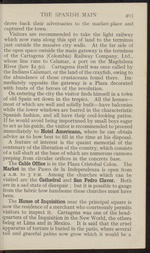| 1 |
 |
“...planted to commemorate peace among the American
nations. Parks and avenues follow closely the direction
of the old walls, the position of which is clearly shown
on the old plan on page 343, and the terms “ intramural ”
and “ extramural ” are still used to define the position
of buildings. La India Park took its name from a
charming statue of an Indian maiden emblematic of
Havana, which was the gift of Count de Villanueva,
the former owner of the property. From Parque
Fraternidad the Prado, or Paseo de Marti, a leafy
boulevard of laurel trees, extends to the Malecon or
sea-wall. In the Central Park is a statue of José
Marti (1853-1895), one of the prime movers in the
revolution of 1895, by the Cuban sculptor, Villalta
de Saavedra.
Facing Central Park are the handsome Capitol with
a stately white dome, the florid Teatro Central, which
can accommodate an audience of 3,000 and, the Centro
Asturiano Club-house....”
|
|
| 2 |
 |
“...s village of Ceiba Mocha (left) and
I ^tensive orange groves (right), the train runs through
the valley of the San Juan river, the great Pan of Matan-
zas (1,000 feet) being the most prominent feature.
Matanzas (population 36,000), the second city and sea-
port of Cuba, is situated on the south and east side of
a spacious harbour. Its streets are well laid out and
it has several handsome plazas adorned with decorative
trees and flowers. A feature of the town is a leafy
boulevard known as the Paseo. The valley of the Yu-
muri, which was praised by Humboldt, is best seen from
the Hermitage of Montserrate and from the summit of
the opposite hill, which is reached through a residential
quarter known as Versailles. The Yumuri Valley is a
vast natural amphitheatre five or six miles in diameter
with precipitous sides except towards the sea, where the
river finds an outlet through the vertical walls of a
canon. It was the scene of a massacre of the Arawaks
m 1511. Hence the names Matanzas (sla...”
|
|
| 3 |
 |
“...being importuned by small boys eager
to act as his guide, the visitor is recommended to proceed
immediately to Hotel Americano, where he can obtain
advice as to how best to fill in the time at his disposal.
A feature of interest is the quaint memorial of the
centenary of the liberation of the country, which consists
of a tall shaft at the base of which are numerous cannons
peeping .from circular orifices in the concrete base.
The Cable Office is in the Plaza Cristobal Colon. The
Market in the Paseo de la Independenza is open from
4 a.m. to 5 p.M. Among the churches which can be
visited are the Cathedral and San Pedro Claver. Both
are in a sad state of disrepair ; but it is possible to gauge
from the fabric how handsome these churches must have
been.
The House of Inquisition near the principal square is
now the residence of a merchant who courteously permits
visitors to inspect it. Cartagéna was one of the head-
quarters of the Inquisition in the New World, the others
being at Lima and in...”
|
|
